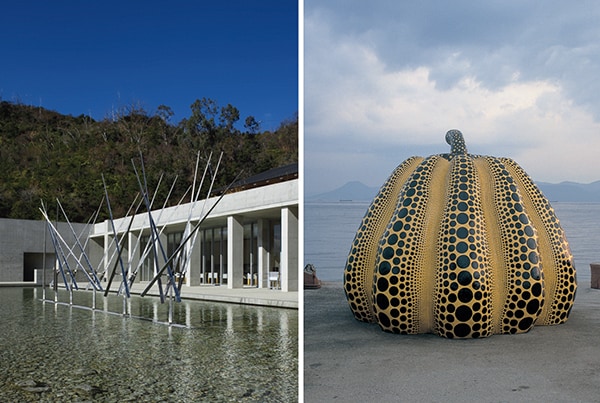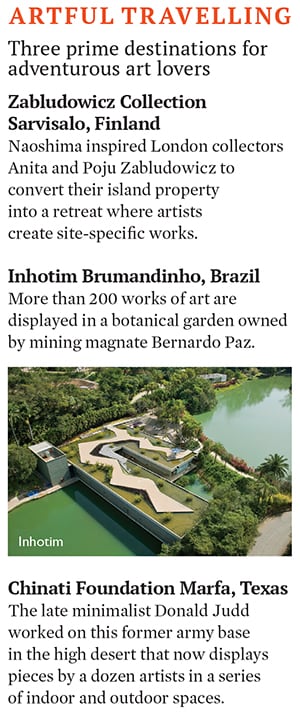
Treasure islands: Creating an archipelago of art
Japanese billionaire Soichiro Fukutake has created a surreal archipelago of art, including an underground museum of Monets and a luxury hotel designed by Tadao Ando
For Japanese billionaire Soichiro Fukutake, the best place to view contemporary art is not a white-walled museum in New York, Paris or even Tokyo. Rather, it’s an archipelago in Japan’s Seto Inland Sea, where he has transformed what were dying industrial waste dumps into a glamorous destination for adventurous art lovers and high-profile collectors like French luxury goods titan François Pinault, Greek industrial magnate Dakis Joannou and Los Angeles arts patron Eli Broad. “Most urban museums are just places for hanging beautiful art,” says the 69-year-old Fukutake. “The art, the building and the environment should work together to wake up the viewer.”
Even if you wake up at 7 am at Benesse House—the $400-a-night hotel where many of Fukutake’s treasures are housed—you can indulge in an experience unique among the world’s finest resorts.With no guards or velvet ropes to block access, there is a museumful of blue-chip works to be explored, including a 1962 Giacometti bronze, a David Hockney swimming pool painting, a whitewashed Jasper Johns alphabet work and, surrounded by a sloping walkway, a 10-foot-tall neon-light sculpture by Venice Biennale winner Bruce Nauman, flashing provocative aphorisms in red, pink, blue and yellow: “Feel and Die”, “Fear and Live … .”
One of Fukutake’s goals for the islands is to see that his collection lives beyond his lifetime. “Through the project, I’m searching for eternity,” he explains. “I want the art to be significant in any age.”
To build his legacy, he has collaborated with Pritzker Prize-winning architect Tadao Ando, known for his minimalist sensibility, improbable angles and liberal use of smooth, unpainted concrete. Together, they have created a complex of elegantly designed structures, three of them carved into the hills of Naoshima Island, a 5-square-mile outpost of rolling terrain, small villages and stunning views of the sea.
Ando’s most striking structure, the Chichu Art Museum (chichu means “underground” in Japanese), is almost entirely below the earth but doesn’t feel that way, with its two courtyards open to the sky and the elements, surrounded by slanted walkways, and skylights in three of the larger rooms. The Chichu houses work by just three artists, including five late paintings from Claude Monet’s water lily series. Before entering the space, visitors must don soft white slippers to avoid soiling the luminous white floor tiles made from Carrara marble. “Many people say that Naoshima is better than l’Orangerie,” says Fukutake. “In Naoshima it’s a spiritual experience.”
Fukutake made his estimated $1.02 billion fortune through his share in Benesse Holdings, a company his late father founded in 1955 as Fukutake Publishing. After his father died of a heart attack in 1986, he changed the name to Benesse, from the Latin words for “well-being”.
Today, Benesse owns the Berlitz language schools, correspondence courses and 275 nursing homes throughout Japan. Under Fukutake’s direction, first as chairman and now as executive advisor, Benesse funnels 5 percent of company shares into the Fukutake Foundation, which supports the art site. He has also invested $240 million of his family fortune into the project.
While Tokyo would be the obvious location for such a museum, Fukutake had come to see the city as a destructive centre of money and stress. “Tokyo is chaos and madness, like New York,” he says. “There is too much—too much entertainment, too many products, too many people.” Better to appreciate art surrounded by the natural world.
In addition to three Ando-designed museums and the museum-cum-hotel, Fukutake has commissioned 20 site-specific works. In 1995, Benesse also established a prize at the Venice Biennale for an artist it would fund to produce a piece for the islands.

Images: Osamu Watanabe; Noboru Morikawa
Artists in Wonderland: the Benesse House park; Yayoi Kasuma’s “Pumpkin” on Naoshima
The first one, by Chinese artist Cai Guo-Qiang, consists of a series of more than 20 rocks placed according to principles of feng shui on a grassy area surrounded by trees just off the beach. The artist set a hot tub in the middle of the work, and hotel guests can make arrangements to soak there while gazing out at the sea.
To determine the best spots for the outdoor pieces and museums, Fukutake flies his private helicopter over Naoshima and two nearby islands, Teshima and Inujima. Finding the works of art scattered between the hotel and the Chichu museum a half-mile up the hill can feel like a scavenger hunt. One piece, by Japanese artist Tsuyoshi Ozawa, is a series of 88 Buddhas in bas-relief on bits of industrial slag. It lies across a pond in an easily missed curve in the road.
While building the museums on Naoshima, including one devoted to the work of Korean-born minimalist Lee Ufan, Fukutake came up with the idea of transforming abandoned homes into works of art. Visitors can take a shuttle bus five minutes from the hotel into the charming village of Honmura, where there are seven so-called “art house projects”. The most striking is a collaboration between Ando, who designed the structure, and James Turrell, the 72-year-old American artist who creates works using light and optical illusions to startling effect.
On Teshima, a beautiful, hilly expanse where Fukutake restored the rice paddies that cover the hillsides, there is another extraordinary museum, unlike anything I have seen. Shaped like a giant teardrop and made out of white cement, it’s nestled in a shallow valley. Two ovals cut into the ceiling let rain fall inside. Visitors must remove their shoes, and attendants admonish them not to get their feet wet. But what appear to be naturally occurring puddles turn out to be the result of tiny underground holes spouting water that then flows down the highly polished floor, looking like glowing pools of mercury. Standing under the sloping roof, I felt like I was in an open-air spaceship moving through a beautiful galaxy of abundant water.

On Teshima, a beautiful, hilly expanse where Fukutake restored the rice paddies that cover the hillsides, there is another extraordinary museum, unlike anything I have seen. Shaped like a giant teardrop and made out of white cement, it’s nestled in a shallow valley. Two ovals cut into the ceiling let rain fall inside. Visitors must remove their shoes, and attendants admonish them not to get their feet wet. But what appear to be naturally occurring puddles turn out to be the result of tiny underground holes spouting water that then flows down the highly polished floor, looking like glowing pools of mercury. Standing under the sloping roof, I felt like I was in an open-air spaceship moving through a beautiful galaxy of abundant water.
Though the Benesse Art Site Naoshima is remote (more than six hours from Tokyo, including three and a half hours on the wonderful Shinkansen bullet train, two different local trains and a 20-minute ferry ride from the sleepy town of Uno) the hotel, which consists of the 10-room museum and three annexes with an additional 55 rooms, was almost fully booked in early June.
While both Benesse Holdings and the Fukutake Foundation administer and fund aspects of the project, all major decisions flow through Fukutake.
Since 2010, the foundation has collaborated with the local government to produce the Setouchi Triennale, where temporary exhibits are scattered around a dozen islands. The next festival will start in March 2016.
But these islands are not a home for Fukutake. Because of his love of nature, he moved from Japan to New Zealand five and a half years ago. He keeps two houses there, in Auckland and on the south island, and flies his two-seater plane between the two. But he spends a quarter of the year in Japan, as much of it as possible in his artful archipelago. “I want people from the big city to envy this place,” he says. “I want to create a new country in Japan.”
(This story appears in the 30 November, -0001 issue of Forbes India. To visit our Archives, click here.)





